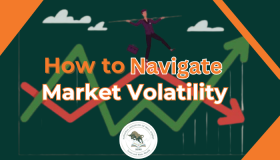31 Aug 2024
How to Navigate Market Volatility: Tips for Stock Traders

Understanding the stock market's ups and downs can be challenging. Volatility, or rapid changes in stock prices, affects the world economy and your personal investment choices. This blog aims to make these concepts easier to grasp and offers practical advice to help traders manage these changes effectively.
Whether you are just starting or have been trading for a while, these tips will help you trade more confidently. At NIWS, a top stock market institute in Delhi, we offer courses that teach you everything from the basics to more advanced strategies. Join us to navigate the stock market confidently.
Understanding Stock Market Volatility
Stock market volatility is about the frequent and fast changes in stock prices. These changes happen every day and are influenced by a few main factors. Traders need to know why the market moves like this. Here's a look at what causes these swings:
#1 Economic Data: Simple reports about jobs, prices in the country, and other important information can move the stock market. For example, if a report shows that prices are going up faster than expected, it might scare investors into thinking that interest rates will also go up, which can cause stock prices to fall.
#2 Geopolitical Events: Political unrest, elections, or big policy changes in important countries can make investors nervous. For instance, if two big trading countries start having political problems, stock markets might react badly.
#3 Market Sentiment: This is just how investors feel about the market's future. If suddenly many investors feel worried, they might sell their stocks, which can push prices down quickly.
Understanding Stock Market Volatility
Volatility in the stock market refers to the change in stock prices over a period, indicating the risk associated with these changes. For instance, a stock that has just had its initial public offering (IPO) often experiences significant price fluctuations. This is because it's new to the market, and investors are still trying to determine its value, resulting in high volatility. In this phase, the returns from such a stock can vary greatly.
Volatility Explained—To measure volatility, we use the standard deviation of the stock's returns, usually expressed annually as a percentage. A higher standard deviation means the stock is more volatile.
Practical Example—Consider Zomato's stock after its IPO. Applying the standard deviation function to its daily returns for the first five days and then annualizing it (multiplying by the square root of the trading days in a year) gives you a clearer idea of its risk. For example, if Zomato's five-day volatility measures 6.36%, this figure reflects the potential for significant price changes over a year.
Tips for Navigating Stock Market Volatility
#1 Stay Informed
Staying informed is crucial to effectively navigating market volatility. For instance, during the 2020 market crash, traders who closely followed COVID-19 pandemic updates were better prepared for the dramatic swings. Keeping up with financial news and updates on global economic conditions, corporate earnings, and geopolitical events helps anticipate potential price changes and supports informed decision-making.
#2 Diversify Your Portfolio
Diversification is essential in managing risk in volatile markets. A study shows that diversified portfolios across at least five sectors can reduce risk by up to 30%. By spreading investments across various asset classes and geographic locations, you mitigate the impact of sharp declines in any single area.
#3 Use Market Dips as Buying Opportunities and Set Stop-Loss Orders
During the market dip in March 2021, investors who purchased tech stocks at lower prices saw significant returns as the sector recovered. Concurrently, setting stop-loss orders, like a 10% drop from the purchase price, can protect against sudden downturns, ensuring you don't lose more than 10% on that investment.
#4 Continue Investing via SIPs and Use Technical Analysis
Regular investment through SIPs can smooth out purchasing costs, as evidenced by the steady growth in SIP contributions in India, which crossed ₹1 lakh crore in 2021. Complementing this with technical analysis, such as the Relative Strength Index (RSI), can help identify potential buy or sell signals, improving investment timing.
#5 Maintain Emotional Discipline and Stay Focused on Your Goals
Maintaining emotional discipline is crucial. Historical data reveals that investors who held onto their investments during the 2008 financial crisis saw their portfolios recover and grow within a few years. Techniques like mindfulness and keeping a trading journal helps maintain focus and control, guiding you through market ups and downs without panic.
Long-Term vs. Short-Term Trading Strategies
Here's a table comparing Long-Term vs. Short-Term Trading Strategies. This table provides a clear, side-by-side comparison of the two trading strategies, highlighting key differences in their approaches, risks, and potential benefits.
| Aspect | Long-Term Trading |
|
|
|---|---|---|---|
| Objective | Achieve steady growth and compound interest over time. | Generate quick profits by capitalizing on market trends. | |
| Volatility Impact | Less affected by short-term market fluctuations. | Highly susceptible to daily market volatility. | |
| Management Style | Hands-off; requires less frequent monitoring and trading. | Hands-on; requires constant monitoring and decision-making. | |
| Risk Level | Generally lower, as exposure to daily market changes is minimal. | Higher due to the need to react swiftly to market changes. | |
| Potential Returns | Potentially lower returns in the short term but can grow significantly over the long term. | It can be high in the short term but risky and inconsistent. | |
| Suitable For | Investors are seeking stability and who have a longer time horizon. | Traders who are experienced and can dedicate time to market analysis. | |
| Trading Costs | Lower, due to fewer transactions and reduced fees. | Higher prices are due to frequent buying and selling, leading to higher transaction fees. |
Conclusion
Navigating stock market volatility can be challenging, but with the right strategies—like staying informed, diversifying, and managing risk—you can protect your investments and even exploit market fluctuations. You’ll be better equipped to succeed in any market environment by staying focused on your long-term goals and maintaining discipline.
